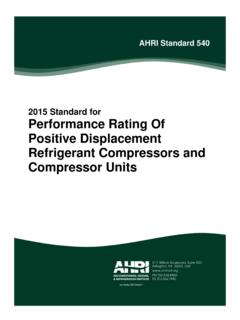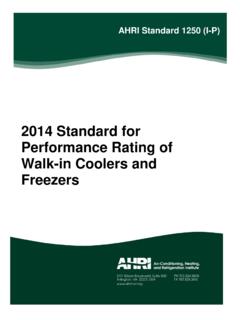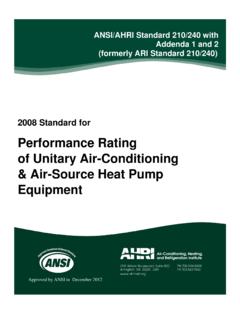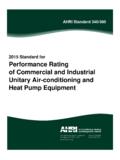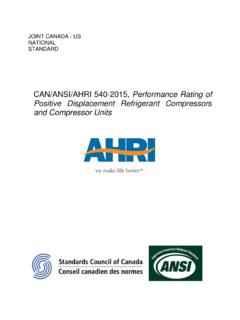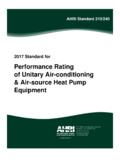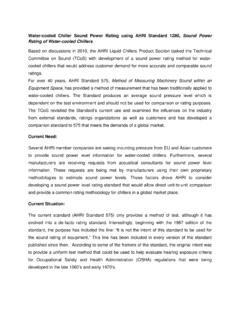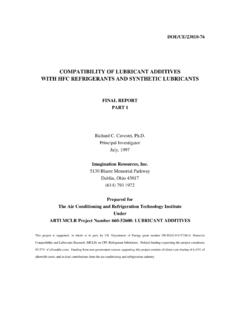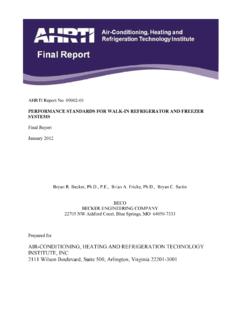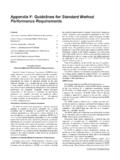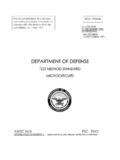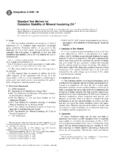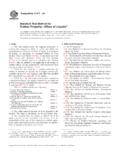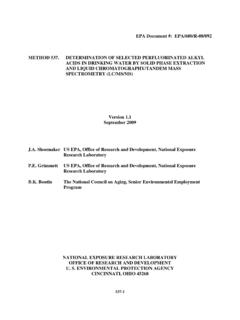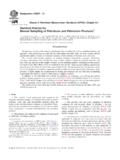Transcription of 2015 Standard for Performance Rating of Liquid to …
1 AHRI Standard 400 (I-P)-2014 ANSI/AHRI Standard 400 (I-P) 2015 Standard for Performance Rating of Liquid to Liquid Heat Exchangers Approved by ANSI on November 6, 2015 Price $ (M) $ (NM) Copyright 2015 , by Air-Conditioning, Heating, and Refrigeration Institute Printed in Registered United States Patent and Trademark Office IMPORTANT SAFETY DISCLAIMER AHRI does not set safety standards and does not certify or guarantee the safety of any products, components or systems designed, tested, rated, installed or operated in accordance with this Standard /guideline. It is strongly recommended that products be designed, constructed, assembled, installed and operated in accordance with nationally recognized safety standards and code requirements appropriate for products covered by this Standard /guideline.
2 AHRI uses its best efforts to develop standards /guidelines employing state-of-the-art and accepted industry practices. AHRI does not certify or guarantee that any tests conducted under the standards /guidelines will not be non-hazardous or free from risk. Note: This Standard supersedes AHRI Standard 400 2001 with Addenda 1 and 2. For the SI ratings , see ANSI/AHRI Standard 401 (SI) 2015 . AHRI CERTIFICATION PROGRAM PROVISIONS The scope of the Liquid to Liquid Heat Exchangers (LLHE) & Liquid to Liquid Brazed & Fusion Bonded Plate Heat Exchangers (LLBF) certification programs are defined below. These scopes are current as of the publication date of the Standard . Revisions to the scope of these certification programs can be found on the AHRI website The scope of these certification programs should not be confused with the scope of the Standard as the Standard covers products that are not covered by a certification program.
3 LLHE Certification Program Scope This program applies to production models of gasketed plate-type heat exchangers that utilize water or sea water on one (1) or both loops, for HVAC applications only. This certification program excludes all of the following: Heat exchangers used for phase-change heat transfer Heat exchangers used for non- Liquid heat transfer Heat exchangers used for food-based processes Heat exchangers with a capacity greater than 240,000,000 Btu/h Heat exchangers with a flow rate greater than 20,000 GPM Heat exchangers with pass arrangements above 3 passes per side Heat exchangers with an unequal number of passes per side LLBF Certification Program Scope This program applies to production models of brazed & fusion bonded plate-type heat exchangers, that utilize water or sea water on one or both loops for HVAC applications only. This certification program excludes all of the following: Heat exchangers used for phase-change heat transfer Heat exchangers used for non- Liquid heat transfer Heat exchangers used for food-based processes Heat exchangers with a capacity greater than 16,000,000 Btu/h Heat exchangers with a flow rate greater than 1,200 GPM TABLE OF CONTENTS SECTION PAGE Section 1.
4 Purpose .. 1 Section 2. Scope .. 1 Section 3. Definitions .. 1 Section 4. Test Requirements .. 2 Section 5. Rating Requirements .. 2 Section 6. Minimum Data Requirements for Published 3 Section 7. Marking and Nameplate 3 Section 8. Conformance 4 APPENDICES Appendix A. References -Normative .. 5 Appendix B. References -Informative .. 6 Appendix C. Method of Test for Liquid to Liquid Heat Exchangers - Normative .. 7 Appendix D. Method of Simulating Field Fouling Allowance Normative .. 12 Appendix E. Lab Test Piping and Instrument Requirements - .. 15 FIGURES FOR APPENDICES Figure D1. Counter Flow .. 12 Figure D2. Parallel 12 Figure E1. Usage of an In-line Static 15 ANSI/AHRI Standard 400 (I-P) 2015 1 Performance Rating OF Liquid TO Liquid HEAT EXCHANGERS Section 1. Purpose Purpose. The purpose of this Standard is to establish for Liquid to Liquid Heat Exchangers: definitions; test requirements; Rating requirements; minimum data requirements for Published ratings ; marking and nameplate data; and conformance conditions.
5 Intent. This Standard is intended for the guidance of the industry, including manufacturers, engineers, installers, contractors and users. Review and Amendment. This Standard is subject to review and amendment as technology advances. Section 2. Scope Scope. This Standard applies to Liquid to Liquid Heat Exchangers as defined in Section 3, which includes the following types of heat exchangers: Plate heat exchangers Shell-and-tube heat exchangers Shell-and-coil heat exchangers Shell-and-U-Tube heat exchangers Exclusions. This Standard does not apply to heat exchangers used for change of phase or non- Liquid heat transfer applications. Section 3. Definitions All terms in this document will follow the Standard industry definitions in the ASHRAE Terminology website ( ) unless otherwise defined in this section. Cold Stream. The Liquid stream with the lower inlet temperature.
6 Field Fouling Allowance. Provision for anticipated fouling during use. Fouling Factor. The thermal resistance due to fouling accumulated on the heat transfer surface. Hot Stream. The Liquid stream with the higher inlet temperature. Liquid to Liquid Heat Exchanger. A heat transfer device used to exchange heat between two Liquid streams that are single phase fluids. Number of Transfer Units (NTU). A dimensionless coefficient representing the magnitude of thermal Performance . The equation for NTU is given in Appendix C. Plate Heat Exchanger. Heat transfer device that typically utilizes corrugated metal plates in a bolted frame. An alternate technique is for the plates to have elastomeric gaskets that seal the unit and direct the heat transfer stream in countercurrent flow. The corrugated plates can also be brazed together using a sacrificial alloy thus avoiding the need for a bolted frame.
7 ANSI/AHRI Standard 400 (I-P) 2015 2 Published ratings . A statement of the assigned values of those Performance characteristics by which a unit may be chosen to fit its application. As used herein, the term Published ratings includes all Performance characteristics shown on the unit or published in specifications, advertising or other literature controlled by the manufacturer, at stated conditions. "Shall" or "Should". "Shall" or "should" shall be interpreted as follows: Shall. Where "shall" or "shall not" is used for a provision specified, that provision is mandatory if compliance with the Standard is claimed. Should. "Should" is used to indicate provisions which are not mandatory but which are desirable as good practice. Shell Type Heat Exchanger. A heat transfer device utilizing an arrangement of multiple hollow cylindrical flow channels (tubes) contained within another larger hollow cylindrical flow channel (shell).
8 The fluid flowing within the tubes exchange thermal energy through the tube wall with another fluid flowing within the shell. This includes Shell-and-tube, Shell-and-U-Tube, and Shell-and-coil Heat Exchangers. Shell-and-tube Heat Exchanger. A bundle of tubes contained in a shell or container. The tube(s) carry a fluid through them, while the shell is also provided with an inlet and outlet for flow of another fluid. Shell-and-U-tube Heat Exchanger. A heat-exchanger system consisting of a bundle of U tubes surrounded by a shell; one fluid flows through the tubes, and the other fluid flows through the shell, around the tubes. Shell-and-coil Heat Exchanger. A heat-exchanger system consisting of helically corrugated tubes surrounded by a shell; one fluid flows through the tubes, and the other fluid flows through the shell, around the tubes. Section 4. Test Requirements Test Requirements.
9 All Published ratings shall be verified by tests conducted in accordance with Appendix C. Section 5. Rating Requirements ratings . Published ratings of Liquid to Liquid Heat Exchangers shall consist of ratings at conditions as elected by the manufacturer to facilitate the selection of equipment. ratings shall contain all information shown in Section When ratings include a Field Fouling Allowance, they shall be calculated by the method specified in Appendix D. Clean Surface Condition. ratings shall be based on tests with initially clean heat transfer surface(s) and conducted in accordance with Section The results of these tests are accepted as reflecting a Fouling Factor of zero. The Fouling Factor or heat transfer margin (if used) shall be agreed upon by the end user and the manufacturer. The manufacturer shall provide published information as to the maximum and minimum recommended flow rates for clean Liquid .
10 Rating Tolerances (Applies to all Products Covered by this Standard ). To comply with this Standard , measured test results shall not be less than 95% of the Published Rating for heat transfer rates and measured values of ANSI/AHRI Standard 400 (I-P) 2015 3 pressure drop shall not exceed Published ratings by more than 15%, or ft of fluid, whichever is greater. Section 6. Minimum Data Requirements for Published ratings Minimum Data Requirements for Published ratings . As a minimum, Published ratings shall include all information shown in Section All claims to ratings within the scope of this Standard shall be accompanied by the statement Rated in accordance with ANSI/AHRI Standard 400 (I-P) . All claims to ratings outside the scope of this Standard shall be accompanied by the statement Outside the scope of ANSI/AHRI Standard 400 (I-P).
